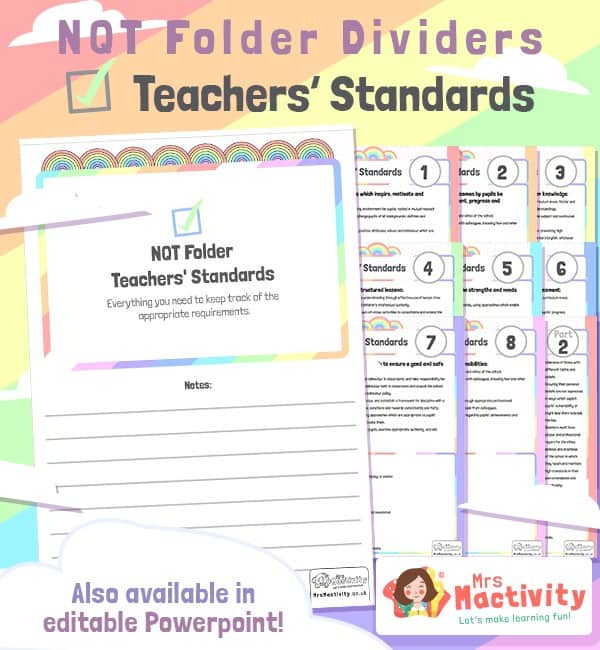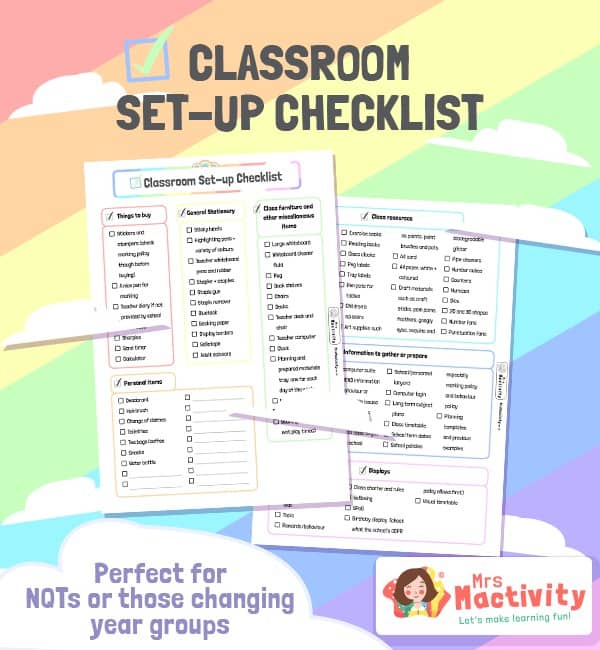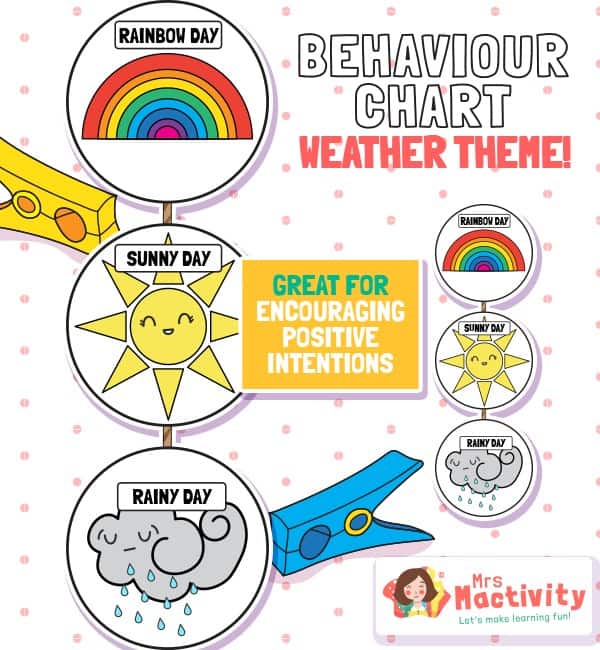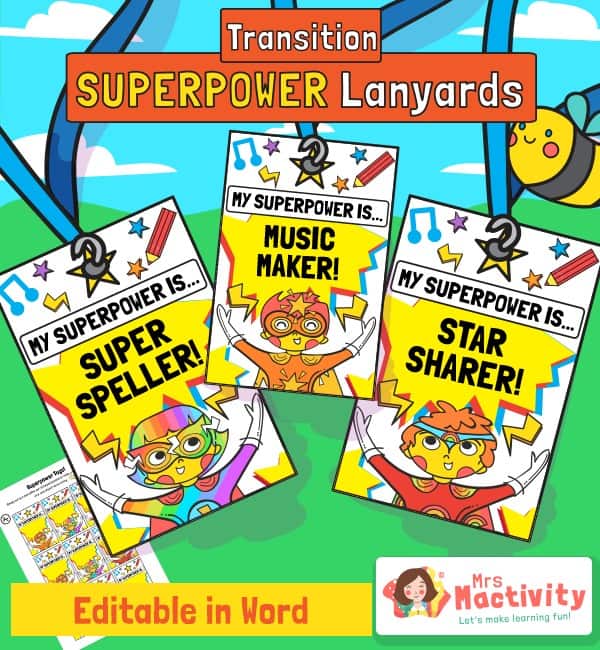Welcome to teaching! It really is the best job there is. We’ve come up with our top tips to help your first year go smoothly. Remember we’re also here to help if you need us anytime, just send us an email over at [email protected] and we’ll do our best!
Top Tips for NQTs
Refer to your school policies for marking, displays, behaviour etc before you spend any time setting things up. That way you don’t have to change work you have already done.
We have a whole category of NQT Resources you can also explore to get you started and help your NQT year go super smoothly! Oh and for those who ask – what does NQT stand for? It means Newly Qualified Teacher – a teacher who is a first year teacher in a school and needs to complete their NQT year to get fully qualified status.
The first thing you need to get your hands on, is a copy of the Teachers’ Standards, as you will need to evidence these throughout your NQT year.

Tips for Setting up Classroom Displays
- Remember that you don’t just have to use backing paper, you can also use PVC, wallpaper, fabric or hessian to make your walls look more interesting.
- You can cover walls with sticky back plastic in order to avoid re-backing frequently, especially if it’s a display you will use frequently (like a working wall).
- You can use bedding (especially children’s bedding with letters or numbers on) to differentiate areas by covering worktops or hanging material around an area.
- Laminate letters for titles so you can re-use it. If you aren’t going to re-use something on your display (e.g. a piece of work by a child) then don’t laminate it.
- Invest in some large zip wallets so at the end of a topic you can store all the display items that you will re-use without them getting lost or damaged.
- Attach a small zip or popper wallet to a corner of your display to keep post-it notes and pens in . That way you or the children can add ideas during a topic.
- Include child size whiteboards underneath your displays so children can answer questions and make them interactive
- You could have small pictures of each child pre-laminated and when a piece of work goes on the wall stick their picture next to it so it is obvious to everyone who has done the work (check your school GDPR policy first though).
- Use table tops in front of display boards as an extension of a display and place additional objects of interest, or questions for the children to answer.
- Our Classroom Set-up Checklist is a very useful starting point to make sure you’ve got everything you need!

Top Tips for Marking
- Before you do anything, check your school’s marking policy so you don’t waste your time.
- Always have a pen you use for marking in your hand as you are walking around checking the children are on task. You can mark the odd question as you go and also leave notes in books about verbal feedback given. When you go back to the books later you can see at what point you worked with them and the advice they was given at the time, and if it had any impact.
- Choose a marking pen that is smooth and comfortable to write with.
- For simple revision or warm-up tasks display the answers on the board so the children can mark themselves or peer mark (when this becomes appropriate).
- Most schools have a different coloured pen that children use to edit and improve their work. If your school doesn’t, then ask about implementing this. This allows the children to improvetheir own work (maybe after reflection on the following day) before you provide any detailedmarking. Many schools use purple pens for this.
- Have the children leave their books in a pile opened on the page that needs marking. Saves valuable time so you don’t have to flick through every single book.
- Ask the children to put their books into three piles – those who have understood the work, those who think they’ve understood the work and those who have struggled. That way you know to spend more time on the struggled pile.
Behaviour Tip Tops for NQTs
- Explore our behaviour management resources.
- Remember that all behaviour is a child’s way of expressing something to you, it might be a need for attention or help and the only way they know how to ask for this is by being disruptive.
- Get your daily routines nailed with our Daily Routines Checklist.

- Think about how you phrase your behaviour requests, instead of saying ‘please can you stop talking to your friend’ say instead ‘thank you for stopping talking to your friend.’ The secondversion expects compliance and rewards it. The first version is giving them a choice as they could respond with ‘no’!
- Ask: (name) what is our rule about ______? Getting the child to repeat the rule helps reinforce it.
- Reinforce instructions with visual cues e.g. touch ear for listen, or show four fingers in the shape of chair legs to reinforce not swinging on their chair. This allows you to address behaviour without any interruption to your teaching.
- Ask: What should you be doing? This is better than telling children what they should be doing as you are reinforcing the expectations around what they should be doing but it is coming from them not you.
- Don’t say ‘don’t kick etc’. Rephrase it to make it positive e.g. ‘keep your feet to yourself’.
- If a child is trying to tell you something in order to distract from doing their work then say ‘maybe he/she did… but for now we need to focus on the task as we will discuss it later’ this way you are avoiding confrontation as you are not denying the incident happened.
- Make comments about behaviour factual and focused on the behaviour not the child. For example: ‘I like the first sentence you have written but …you have not been listening 3 times when I have looked at you’.
- Give the child the positive choice as well as the consequence e.g. ‘if you choose to continue
to kick her you will choose a sad face but if you stop nothing will happen’ then reinforce correct behaviour with praise. This makes children aware of positive rather than just negative consequences. - Reward children who tell you something positive that has happened at playtime and the child that did the positive action. This avoids children seeking attention by telling you problems at playtime.
- Give children who are prone to fiddling reasons to move such as handing out books, this letsthem release energy so they can concentrate.
- Meet and greet your children every day at the door and take the time to talk to every child. Make a comment related to a previous conversation ‘I see your favourite football team won last night’ or ask them a question to show you are paying attention to them ‘Is that a new coat?’ Investing in this time helps build up the relationships with your class, which are key to positive behaviour.
- Try and stick with the acronyms PIP and RIP. Praise in Public, Reprimand in Private. Make the most ‘famous’ child in your classroom the best-behaved one not the most challenging one.
- Build relationships with parents too. Use the school procedures on sending text messages, emails or postcards home to share positive behaviour.
- Some children may need personalised behaviour strategies. Print off two pictures of theirfavourite team, toy, animal etc then laminate them. Cut up one of them into jigsaw pieces. The child adds a piece to their jigsaw each time they do something positive. Have an agreed reward ready for when they complete their jigsaw. Younger children will need less pieces and more frequent rewards than older children.
- You may also need to write behaviour contracts for some children who are struggling. Thisshould be simple and child friendly. In the first column write the behaviour that is the issue but phrased positively so for example if they are taking things from other children’s trays then write ‘I will only go into my own tray’. In the second column write the consequence if that rule isn’t followed. Make sure parents and leadership sign and agree to this so it is important to the child.
- If you need to talk to a child about something later in the day start with ‘I need to talk to you about ______’ and disclose the issue from the outset rather than ‘Can I have a word after play’ which makes children panic because they can’t prepare themselves from the conversation.
- When you are discussing behaviour say how the situation makes you feel – they can’t argue with this as only you can say how something makes you feel. For example ‘shouting out when I am talking makes me feel sad
- Look for positive role models and praise them.
- Track behaviour using ABC (Antecedents, Behaviour and Consequence) so you can work out reasons for problems by looking at patterns. For example there is always an issue before lunchtime because they are worried if they have been sent in enough lunch to eat from home.
- Some schools encourage a visual representation of behaviour such as this smiley face behaviour chart and weather themed behaviour chart.


- Having a whole class reward to work towards helps build up a sense of comradery within the class and a sense of a shared purpose. It could be as simple as filling a jar with marbles. The key is agreeing the reward beforehand (e.g. 10 minutes extra playtime) so that all the children know what they are working towards.
- Reward children with special jobs. For example you could have a ‘star of the day’ and the following day that child is given the responsibility of taking the register or taking resources to other adults when needed. Also allowing that child to pick a friend to help
- Give ways to indicate to anyone who enters your classroom children who are doing well. Make brag tag lanyards for different subjects e.g. ‘maths superstar’, ‘spelling whizz’ etc so that when other adults enter the room you can encourage them to notice and praise these children. They could also be given special jobs for example the ‘times table superstars’ could be allowed to test other children on theirs.

- Have class targets that can be achieved quickly and that result in rewards. Pick something that is an issue (e.g. lining up quietly) and make the target for that week ‘We will all line up quietly’ so you can really focus on reinforcing that behaviour at every opportunity all week. When it is achieved share a reward then move onto the next small target. Keep referring back to targets from previous weeks.
Download these NQT top tips in one handy booklet right here! Don’t forget to explore our recovery curriculum resources too.







